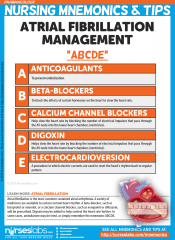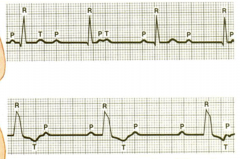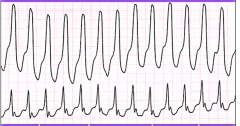![]()
![]()
![]()
Use LEFT and RIGHT arrow keys to navigate between flashcards;
Use UP and DOWN arrow keys to flip the card;
H to show hint;
A reads text to speech;
87 Cards in this Set
- Front
- Back
- 3rd side (hint)

|
Sinus Bradycardia Regular rate <60 bpm P:QRS= 1:1 PR = .12-.20 QRS < .12 Tx: if symptomatic, TCP (trans-cutaneous pacing) |
|
|

|
Sinus Tachycardia Regular Rate >100 bpm P:QRS= 1:1 PR = .12-.20 QRS < .12 |
|
|
|
Sinus Bradycardia 1. causes 2. Tx 3. complications |
Sinus brady- fix if symptomatic, hypotensive, hypovolemia,dizzy, low O2 sat, CAREFUL CONSTIPATION, check if pt vagaling, fall precautionseven if asymptomatic, Causes:cns depressant Rx, antiepilepsy Rx, opioids, Phenergan, Benadryl, Atropine-increases HR, ok to leave at bedside just in case. KNOW HOW TO GIVE IT!!! |
|
|
|
Sinus tachycardia 1. causes 2. Tx 3. complications |
Causes: fever, pain, stress,caffeine, Tx if symptomatic asymptomatic or normalcompensatory response- no need to fix rate, fix cause (pain, fever, stress, caffeine) |
|
|

|
Atrial fibrillation irregular a: 350-650, v: slow to rapid Pwave- fine to course fib PR- none QRS < 0.12 |
|
|
|
Afib causes treatment Rx complications |
Causes- Rx, congenital, neuro, stroke, HF,ischemic dx, hyperthyroidism, common in geriT Tx: Must try to fix, 1st medications if patient is stable 2nd cardiovert or ablation (after anticoag tx) must have consents. Rx: anticoags, rate controllers, and rhythm controllers. Calcium channel blockers. (Dilitiazem, Verapamil) If unable to convert w/i 48 hrs w/ Rx or if the patient becomes unstable we anticoagulate ( usually heparinpossibly a drip) and synchronize cardiovert. .Potassium channel blocker- amiodarone-KNOW how to give it, often stable pts on PO amiodarone. In CC we give via ivdrip then send home w/ PO, if amiodarone doesn’t fix- need cardioversion(elective cardioversion MUST have consent), ablation (consent), s/soften asymptomatic complications:clots- need anticoag therapy, |
|
|
|
amiodarone (Cordarone) |
K+ channel blocker, NEVER for av blocks. Tx: tachy dysrhythmias slows SA rate, increases PR & QT intervals, systemic vasodilation PO for stable and d/c pts. CXR b4 & q 3mos, opthamologist b4 & q 6 mos, Liver & thyroid labs b4 & q6mos, IV for inpatient. IV must have continuous ECG a/e: HoTN, PR prolongation, QRS widen, U waves, bradycardia, pulmonary toxic- crackles, low RR, friction rub, Neurotoxic- parasthesia, tremors, visual - halos, photophobia, vision loss, Thyroid- lethargy, wt gain, edema, cool/pale skin (hypoT), tachy, wt lossn insomnia (hyperT) |
|
|

|
Atrial flutter regular or variable A: 220-430, V <300 P wave sawtooth PR- none QRS <0.12 |
|
|
|
Atrial flutter causes Tx complications |
causes: unhealthy heart, CAD, MTN, mitral valve, PE, COPD, corpulmonale, HyperThyroid Drug tox: dig, quinidine, epi Complications- emboli, stroke, HF, low CO Tx: warfarin, Ca++ blocker (diltialzem), Beta blocker, cardiovert (consent), ablation (consent) |
|
|
|
Stroke Moderate-risk factors |
Age ≥75 yr Heart failure Hypertension LV ejection fraction ≤35% Diabetes mellitus |
|
|
|
Stroke High-risk factors |
Previous stroke, TIA, or embolism Mitral stenosis Prosthetic heart valve‡ |
|
|

|
PVC- premature ventricular contraction irregular extra QRS (very wide) unifocal or multifocal bigeminy= every 2nd qrs trigeminny= every 3rd qrs 3+ consecutive pvc = Vtach |
|
|
|
PVC causes treatment complications |
causes: Uusally electrolyte, caffeine, stress, fever, Mitral prolapse, HF, CAD, epi, dig Complications: none if healthy heart, low CO, HF Tx: electrolyte, Beta blockers, O2, procainamide, amiodarone MUST treat if more than 4 PVC/min (Vtach) |
|
|

|
SVT- supraventricular tachycardia regular 140-220 bpm (faster than sinus tac) P usually overlap w/Twave QRS <0.12 impulses come from tissue around AV node (not SA node) |
|
|
|
SVT s/s causes complications Tx |
s/s: syncope, dizzy, SOB, poor perfusion, sweaty, cold Complications: LOC, chest pain Tx: must treat even if asymptomatic bc they will decompensate 1. vagal stim (blow straw, poop) 2. adenosine to slow rate (must have code cart, atropine bedside, may reduce HR to 0, then give atropine, must have stop cock- push, flush, push, flush fast, Px fibrillation pads) 3. cardiovert (consent, pain, sedation) |
|
|
|
Hypocalcemia effects on EKG |
1. QT prolongation primarily by prolonging the ST segment. T wave is typically left unchanged. 2. atrial fibrillation has been reported. 3. Torsades de pointes may occur, but is much less common than with hypokalaemia or hypomagnesaemia. |
|
|
|
Hypercalcemia effects on EKG |
1. shortening of the QT interval 2. In severe hypercalcaemia, Osborn waves (J waves) may be seen 3. Ventricular irritability and VF arrest has been reported with extreme hypercalcaemia |
|
|
|
shockable rhythms |
Vtach- pulseless only Vfib |
|
|
|
Non- shockable rhythms how do we treat |
Asystole, PEA (pulseless electrical activity) 1. CPR 2. Rx- epi, 3. Intubation 4. Correct underlying causes (Mg+, H+, etc.) |
|
|
|
MI causes- Patch MD |
P- pulmonary embolus A- acid or alkalosis T- Tension pneumothorax C- Cardiac tamponade H- hyper/o- K, Mg, Ca electrolytes M- MI D- dehydration/ Drug overdose |
|
|
|
Ventricular Arrhythmia Mgt PALS |

|
|
|
|
Atrial Fibrillation Mgt ABCDE |

|
|
|
|
Potassium channel blockers- pharm cardioversion beta blocker- satalolol slow down the electrical signals that cause AFib. a/e Torsades de Pointes Tx: Afib, ACLS |
|
|
|
Flecainide(Tambocor®), Propafenone (Rythmol®) Quinidine (Various). |
Na channel blockers- pharm cardioversion slow conductivity of heart tx: Afib, A flutter, SVT, Vtach |
|
|
|
Digoxin |
positive inotrope slows HR, increases contraction strength Tx: HF, 0.5-2.0 ng/mL Toxicity: |
|
|
|
atenolol bisoprolol carvedilol metroprolol nadolol propranolol timolol |
Beta blockers slow HR, decrease cardiac O2 requirements, relieve angina what else??? |
|
|
|
Dilitiazem Verapamil |
Ca++ Channel blockers slow HR , what else?? Tx: Afib, Aflutter, |
|
|
|
Pacemaker indications |
3rd degree av block SVT junctional rhythm idio rhythm A flutter Vtach |
|
|
|
Modes of pacemakers |
Transcutaneous Temporary transvenous (usually IJ can be subclavian or femoral) |
|
|
|
pacemaker malfunctions |
manufacturer interrogation to dx pt will return to previous rhythm float a temporary transvenous until replacement |
|
|
|
pacemaker complications |
loose leeds |
|
|
|
Pacemaker nursing considerations |
do not adjust amplitude or rate (only MD) |
|
|
|
Cardiac Hs & Ts |
Hs 1. HypOvolemia 2. Hypoxia 3. H+- acidosis 4. Hypo/er K Ts 1. Tension pneumothorax 2. Tamponade 3. Thrombus- coronary 4. Thrombus- pulmonary 5. Toxins |
|
|
|
Overdamped waveform arterial line troubleshooting steps |
1. check that transducer at phlebostatic axis 2. assess catheter insertion site 3. check tubing, leaks, disconnections, bubbles 4. Make sure flush bag has fluid pressure bag 300 mmHg 5. aspirate discard, then flashflush catheter, replace vented cap. |
|
|
|
Underdamped waveform arterial line troubleshooting steps |
1. assess pt HoTN, HTN 2. transducer at phlebostatic axis 3. check tubing/ flush bubbles 4. make sure length of tubing adequate |
|
|

|
1st degree AV block regular rate A: 60-100, V: low PRI: >0.2 sec QRS: usually normal |
|
|
|
1st degree AV block s/s causes Tx |
s/s usually asymptomatic causes: MI,CAD, rheumatic fever, hyperthyroidism, electrolyte imbalances (e.g.,hypokalemia), vagal stimulation, and drugs such as digoxin, β-adrenergic blockers, calcium channelblockers, and flecainide. Tx: if symptomatic, symptoms only. asymptomatic- increase monitoring |
|
|

|
2nd degree AV block type 1 mobitz I, wenkebach a rate= normal, v rate= slower PRi incresingly prolonged until QRS skipped. then cycle restarts QRS |
|
|
|
2nd degree av block causes complications Tx |
causes: dig, beta blockers, CAD, MI complications: bradycardia Tx: may progress, atropine if bradyC, transcut pacing, temp pacemaker |
|
|

|
2nd degree av block type 2 mobitz II a rate= regular, V rate= irregular PRI normal or prolonged w/ intermittant missed QRS QRS usually >0.12 |
|
|
|
2nd degree av block type II causes complications Tx |
causes: rheumatic, CAD, anterior MI, Rx toxicity Complications: --> 3rd degree, bradyC, low CO, HoTN, MI Tx: MUST treat! pacemaker |
|
|

|
3rd degree av block Irregular A rate= 60-100, v rate= 40-60 Pri- varies, nonconductive QRS- normal (block above His) prolonged (block below His) |
|
|
|
3rd degree AV block causes complications Tx |
causes: bad CAD, MI, myocarditis, dig, beta blockers, Ca++ blockers complications- low CO, MI, HF, shock Tx: atropine, dopamine, epi, maintain HR & BP until pacemaker avail. transcutaneous pacemaker TWO Chamber pacemaker!! |
|
|

|
ventricular tachycardia ** 3+ consecutive PVC rate 150-250 no P QRS > 0.2 sec |
|
|
|
V tach w/ pulse Tx |
1.IV procainamide, sotalol, amiodarone,
2.IV Mg, isoproterenolol, 3.phyenytoin (Dilantin) or 4.percutaneous pacing. Cardioversion (synchronized Dfib) |
|
|
|
Vtach pulseless Tx |
1.CPR (if alone- Dfib first) 2.Dfib 3.Vasopressors(epi), 4. antidysrythmics (amiodarone) |
|
|
|
Vtach complications |
Complications- very low CO, HoTN,pulmedema, LOC, cardiac arrest Tx:FAST!!! even if pt has pulse will decompensate to Vfib or asystole |
|
|

|
Ventricular fibrillation no measurable rate no P, qrs, t pulseless pt! Afib = Dfib |
|
|
|
Vfib Tx |
1.CPR 2.Dfib 3.Pressors- epi, pitressin 4. antiarrhythmics- amiodarone |
|
|
|
Vfib causes |
MI, ischemia, HF, cardiomyopathy. coronaryreperfusion after thrombolytic therapy. hyperkalemia, hypoxemia, acidosis, and drug toxicity. |
|
|

rhythm Tx |
Asystole Tx: NO SHOCK 1. CPR 2. EPI 3. Intubate |
|
|
|
PEA- pulseless electrical activity EKG looks like Causes Tx |
EKG looks like anything but - NO PULSE Tx: NO SHOCK 1. CPR 2. Rx- epi, usually Mg++ 3. Intubation 4. Tx cause (acidosis, drug overdose, tamponade, hypo/erK, tension pneumothorax, PE, MI, hypothermia |
|
|

|
Torsades de Pointes Vtach w/ multifocal qrs looks like twisting ribbon QT- long |
|
|
|
Torsades de Pointes causes |
HypOMg+ HypOCa++ HypOK+ Rx: amioderone, soltalol HCl (Betapace), dofetilide |
|
|
|
Torsades de Pointes Tx |
IV Mg sulfate Isoproterenol Cardioversion (Dfib w/ synchronization) Pacemaker |
|
|
|
Cardioversion considerations |
1. Consent- elective may cause Vfib or asystole 2. analgesic & sedation 3. 50-200 joules 4. continuous EKG 5. Crash cart w/ Rx at bedside |
|
|
|
Defibrillation considerations |
1. Emergency- no consent 2. Tx for Vfib or pulseless Vtach 3. No CO 4. 200-350 joules 5. client unconsious- no sedation/analgesic necessary 6. continuous EKG 7. may cause vtach to vfib or asystole |
|
|
|
AICD |
automatic implantable cardioverter/ defibrilllator 1 or 2 chamber (atrial or ventricular or both) Tx: blocks, SVT, junctional, ido, a flutter, Vtach |
|
|
|
Etiology of arrhythmias |
|
|
|
|
Goal of arrhythmia Tx |
1. early dx of s/s 2. Px complications 3. maintain normal CO |
|
|
|
Arrhythmia Tx |
1. Rx increase contractility rhythm, blockage, MI 2. Clear blockage, rx or cath 3. Tx hypovolemia, fluids, blood |
|
|
|
s/s low CO |
|
|
|
|
chest pain interventions |
|
|
|
|
MI interventions |
MONA-B
|
|
|
|
NSTEMI |
unstable angina >30 min normal or depressed ST - lasts weeks/yrs T may invert- normal after a few wks, yrs Cardiac markers present |
|
|
|
STEMI |
sinus elevated ST depressed Q wave- permanent Cath lab ASAP, usually CABG * almost always clot U wave = old STEMI (inferior) |
|
|
|
MI causes |
Atherosclerosis age obese DM smoker birth control pill vasospasm- cocain, plt issues embolus- Afib, left side clot, vegitations of endocarditis |
|
|
|
Common areas of MI |
1. Outer area 2. area of injury 3. infarct |
|
|
|
MI outer area |
ischemia- pt can compensate, may see ST depression |
|
|
|
MI area of injury |
may reperfuse if fast response time give lots of O2 to help save this area ST elevation |
|
|
|
MI infarct area |
necrotic region-irreversible q wave depression permanent |
|
|
|
Acute Stemi hours 1-2 days weeks |
hours- ST elevation days- t wave inversion, st normal weeks- persistant q wave |
|
|
|
HypOK+ causes s/s |
<3.0 Causes: diarrhea, vomiting, fistula, NG suction, diuretics, diaphoresis, dialysis, alkalosis, stress, insulin s/s: fatigue, cramps, n/v, ileus, parasthesia, weak reflexes, irregular pulse, polyuria, hypERglu |
|
|
|
HypER-K+ causes s/s |
cause- #1 kidney railure, cytolysis, infection, acidosis, salt substitutes >5.5 s/s Anxiety• Abd cramping, diarrhea• Weakness of lower extremities• Paresthesias, irregular pulse |
• Tall, peaked T wave• Prolonged PR interval• ST segment depression• Loss of P wave• Widening QRS• Ventricular fibrillation• Ventricular standstill |
|
|
life threatening low K hi K |
<2.5 >6.5 |
|
|
|
KCl - IV considerations |
|
|
|
|
HypO-K+ EKG changes |
flat/depressed T wave U wave depressed ST long QRS PVCs, bradycardia |
|
|
|
HypER-K+ |
peaked T wave, long PRi, ST depression, wide QRS, Vfib, V arrest |
|
|
|
PAWP |
pulmonary artery wedge pressure measure w/ swan-ganz 6-12 mmHg |
|
|
|
SVR |
systemic vascular resistance 800-1200 dynes/sec/cm |
|
|
|
CO |
cardiac output 4-8 L/min |
|
|
|
CI |
Cardiac index CO/BSA 2.2-4 L/min/m2 |
|
|
|
MAP normal equasion |
(SBP + 2DBP)/2 normal 70-105 <60= poor cerebral perfusion |
|
|
|
CVP |
central venous pressure 2-8 mmHg |
|
|
|
PA and atrial lines pressure bag set to |
300 mmHg |
|
|
|
Adenosine- does what must have what at bedside |
tx: SVT, slows HR sometimes to zero, very short duration NEVER for av blocks ***must have atropine |
|
|
|
Epi treats |
pulseless pts allergy |
Y |

